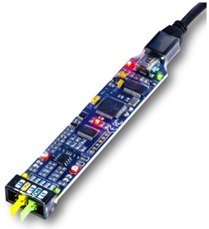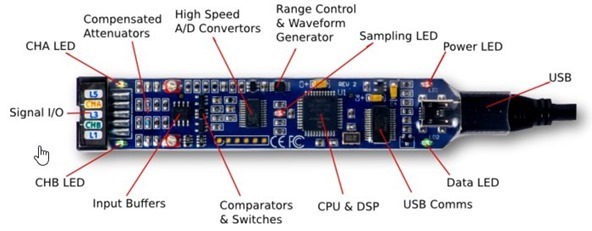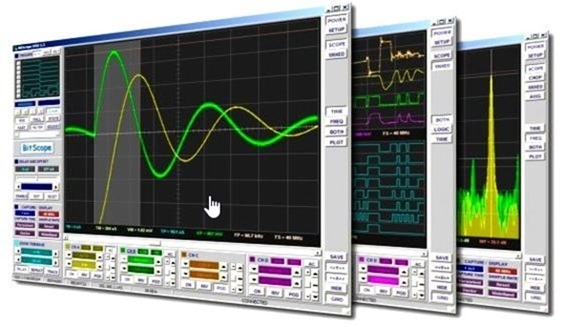This morning saw a bumper crop in the post – including – the BitScope Micro which is a usb oscilloscope, logic probe, signal generator and much more. I already have nScope but I wanted something just a little more advanced as a general purpose tool. I even did an opening video here.
 So – what is Bitscope Micro? It’s a thin circuit board which plugs into USB and be it on a PC or Linux (Raspberry Pi) etc, forms the basis of a simple oscilloscope, logic analyser and a whole lot more. Below right on the screen you’ll see the device itself, just a slim PCB with a plastic cover – and a connector at one end. The company also do an adaptor for BNC connectors and a base to put a Raspberry Pi and screen on to make a complete test instrument. Here’s the spec..
So – what is Bitscope Micro? It’s a thin circuit board which plugs into USB and be it on a PC or Linux (Raspberry Pi) etc, forms the basis of a simple oscilloscope, logic analyser and a whole lot more. Below right on the screen you’ll see the device itself, just a slim PCB with a plastic cover – and a connector at one end. The company also do an adaptor for BNC connectors and a base to put a Raspberry Pi and screen on to make a complete test instrument. Here’s the spec..
 20 MHz Bandwidth.
20 MHz Bandwidth.
- 40 MSps Logic Capture.
- 2 Analog Scope Channels.
- 2 Analog Comparator channels.
- 6 Logic/Protocol Analyzer channels.
- 8 & 12 bit native analog sample resolution.
- Decodes Serial, SPI, I2C, CAN and more.
- Windows, Linux, Mac OS X & Raspberry Pi.
- Built-in analog waveform & clock generators.
- User programmable, C/C++, Python, VM API.
- Tiny, light weight (14g) and water resistant.
- Standard oscilloscope probe adapters available.
It came from Australia but you can apparently get them from Farnell in the UK.
So – how does it actually work in practice? The software – and there is LOTS of it – is free for PC, Linux and other systems. You could put it on a Raspberry Pi – I prefer to have it running on my PC. This is not only a logic analyser and scope but it also has signal generation – from 5hz to 250Khz.
How well does it work? Well, up to now I like it – I plan to take it with me to Spain this summer where I don’t have a scope and hopefully for general purpose work it will do the job though clearly it is not intended to replace an expensive scope.
And yes the screens DO look as good as these. There are filters to get rid of the bit noise you often see on this kind of scope – but you can turn it off and the scope software is intended for use on a PC but just as happy on a touch interface. I’ve a NanoPC T2 with a touch screen that is VERY likely to turn into an oscilloscope this summer ![]()
I could rant on for ages but there is a LOT on their website..
Summary – looks well made, more as I gain experience of this – won’t replace my 50Mhz dual beam scope but then that is an arm-breaker to carry around and this fits in a tiny corner of my case along with the laptop.



Hi Peter,
I am a undergraduate student and I am a beginner of using bitscope.
I would like to try to use bitscope to obtain semiconductor devices output I-V characteristic curve. Have you got some ideas of the related things?
Thanks
Ideas, anyone?
if you need for troubleshooting, get a real one 🙂
I have two real ones. Not everyone needs an expensive scope.
Starter OSC is not expensive 😀
Or even a “proper” scope.
Will be interested in how you find this, i was looking at getting a Microchip serial analyser which is about £30, CPC have these for a about £70. cheaper than i can find on ebay.
does not seem to have much capture memory so i wounder if you will find that an issue, all reviews i’ve seen so far do not go much beyond generating a sine-wave and then displaying it. i hope you’re be giving it a harder life. would like to see how it copes with SPI, I2C traffic from an ESP8266 while there is RF flying around.
my main use would be debugging coms traffic where i seem to get the most issues with timing etc.